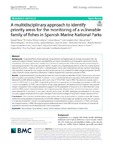Mostrar o rexistro simple do ítem
A Multidisciplinary Approach to Identify Priority Areas for the Monitoring of a Vulnerable Family of Fishes in Spanish Marine National Parks
| dc.contributor.author | Planas Oliver, Miquel | |
| dc.contributor.author | Piñeiro-Corbeira, Cristina | |
| dc.contributor.author | Bouza, Carmen | |
| dc.contributor.author | Castejón-Silvo, Inés | |
| dc.contributor.author | Vera, Manuel | |
| dc.contributor.author | Regueira, Marcos | |
| dc.contributor.author | Ochoa, Verónica | |
| dc.contributor.author | Bárbara, Ignacio | |
| dc.contributor.author | Terrados, Jorge | |
| dc.contributor.author | Chamorro, Alexandro | |
| dc.contributor.author | Barreiro, Rodolfo | |
| dc.contributor.author | Hernández-Urcera, Jorge | |
| dc.contributor.author | Alejo, Irene | |
| dc.contributor.author | Nombela, Miguel | |
| dc.contributor.author | García, Manuel Enrique | |
| dc.contributor.author | Pardo, Belén G. | |
| dc.contributor.author | Peña, Viviana | |
| dc.contributor.author | Díaz-Tapia, Pilar | |
| dc.contributor.author | Cremades, Javier | |
| dc.contributor.author | Morales-Nin, Beatriz | |
| dc.date.accessioned | 2021-05-25T10:06:17Z | |
| dc.date.available | 2021-05-25T10:06:17Z | |
| dc.date.issued | 2021-01-21 | |
| dc.identifier.citation | Planas, M., Piñeiro-Corbeira, C., Bouza, C. et al. A multidisciplinary approach to identify priority areas for the monitoring of a vulnerable family of fishes in Spanish Marine National Parks. BMC Ecol Evo 21, 4 (2021). https://doi.org/10.1186/s12862-020-01743-z | es_ES |
| dc.identifier.issn | 2730-7182 | |
| dc.identifier.uri | http://hdl.handle.net/2183/27995 | |
| dc.description.abstract | [Abstract] Background: Syngnathid fishes (Actinopterygii, Syngnathidae) are flagship species strongly associated with seaweed and seagrass habitats. Seahorses and pipefishes are highly vulnerable to anthropogenic and environmental disturbances, but most species are currently Data Deficient according to the IUCN (2019), requiring more biological and ecological research. This study provides the first insights into syngnathid populations in the two marine Spanish National Parks (PNIA—Atlantic- and PNAC—Mediterranean). Fishes were collected periodically, marked, morphologically identified, analysed for size, weight, sex and sexual maturity, and sampled for stable isotope and genetic identification. Due the scarcity of previous information, habitat characteristics were also assessed in PNIA. Results: Syngnathid diversity and abundance were low, with two species identified in PNIA (Hippocampus guttulatus and Syngnathus acus) and four in PNAC (S. abaster, S. acus, S. typhle and Nerophis maculatus). Syngnathids from both National Parks (NP) differed isotopically, with much lower δ15N in PNAC than in PNIA. The dominant species were S. abaster in PNAC and S. acus in PNIA. Syngnathids preferred less exposed sites in macroalgal assemblages in PNIA and Cymodocea meadows in PNAC. The occurrence of very large specimens, the absence of small-medium sizes and the isotopic comparison with a nearby population suggest that the population of Syngnathus acus (the dominant syngnathid in PNIA) mainly comprised breeders that migrate seasonally. Mitochondrial cytochrome b sequence variants were detected for H. guttulatus, S. acus, and S. abaster, and a novel 16S rDNA haplotype was obtained in N. maculatus. Our data suggest the presence of a cryptic divergent mitochondrial lineage of Syngnathus abaster species in PNAC. Conclusions: This is the first multidisciplinary approach to the study of syngnathids in Spanish marine NPs. Habitat preferences and population characteristics in both NPs differed. Further studies are needed to assess the occurrence of a species complex for S. abaster, discarding potential misidentifications of genus Syngnathus in PNAC, and evaluate migratory events in PNIA. We propose several preferential sites in both NPs for future monitoring of syngnathid populations and some recommendations for their conservation. | es_ES |
| dc.description.sponsorship | Study funded by Proyecto Hippoparques (1541S/2015 and 1580S/2015; Organismo Autónomo de Parques Nacionales—OAPN, Ministerio de Agricultura, Alimentación y Medio Ambiente, Spain). Project 1580S/2015 was in charge of genetics | es_ES |
| dc.language.iso | eng | es_ES |
| dc.publisher | Springer Nature | es_ES |
| dc.relation | info:eu-repo/grantAgreement/MAAMA/Plan Estatal de Investigación Científica y Técnica y de Innovación 2013-2016/1541S%2F2015/ES/Signátidos de los parques nacionales de las Islas Atlánticas y del Archipiélago de Cabrera | |
| dc.relation | info:eu-repo/grantAgreement/MAAMA/Plan Estatal de Investigación Científica y Técnica y de Innovación 2013-2016/1580S%2F2015/ES/Caracterización genética de signátidos de los parques nacionales de las Islas Atlánticas y del Archipiélago de Cabrera | |
| dc.relation.uri | https://doi.org/10.1186/s12862-020-01743-z | es_ES |
| dc.rights | Atribución 4.0 Internacional (CC BY 4.0) | es_ES |
| dc.rights.uri | https://creativecommons.org/licenses/by/4.0/ | * |
| dc.subject | National park | es_ES |
| dc.subject | Syngnathids | es_ES |
| dc.subject | Habitat | es_ES |
| dc.subject | Stable isotopes | es_ES |
| dc.subject | Genetic identification | es_ES |
| dc.subject | Conservation | es_ES |
| dc.title | A Multidisciplinary Approach to Identify Priority Areas for the Monitoring of a Vulnerable Family of Fishes in Spanish Marine National Parks | es_ES |
| dc.type | info:eu-repo/semantics/article | es_ES |
| dc.rights.access | info:eu-repo/semantics/openAccess | es_ES |
| UDC.journalTitle | BMC Ecology and Evolution | es_ES |
| UDC.volume | 21 | es_ES |
| UDC.startPage | 4 | es_ES |
| dc.identifier.doi | 10.1186/s12862-020-01743-z |






